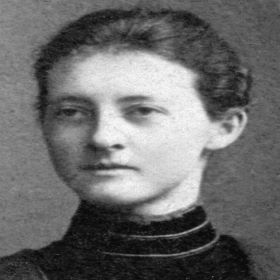

For the Week of Monday, September 26, 2022
On October 1, 1903, Dr. Clara C. Benson published “The Composition of the Surface Layers of Aqueous Amyl Alcohol” in the Journal of Physical Chemistry. This trailblazing scientist went on to become one of the first female professors at the University of Toronto.
Clara Benson was born in Port Hope, Ontario in 1875 to Laura Abigail Fuller and Thomas Moore Benson, who was a barrister and later a judge. Her privileged socio-economic position afforded her greater access to education than most women of her generation. In 1895—eleven years after women were first admitted—she enrolled in University College at the University of Toronto. She was the first female student at the university to complete a Bachelor of Arts in chemistry (1899) and one of the first to complete a doctorate, graduating with a Doctor of Philosophy in physical chemistry in 1903.
Denied opportunities in the field of physical chemistry because of her gender, in 1905 Benson began working as a Demonstrator in Food Science at the Lillian Massey School of Domestic Science at the University of Toronto. She had previously signed a petition opposing this interdisciplinary program focused on skills, theories, and sciences associated with the management of a household, and the assumption that women were best suited to this field of study. Despite her earlier objections, Benson accepted the job. The first woman promoted to rank of Lecturer (1905), she became Associate Professor following the creation of the Faculty of Household Science in 1906, and then Full Professor and Head of the Department of Food Chemistry in 1926.
In the years that followed, she focused her scientific research on food chemistry, analyzing proteins, fats, carbohydrates, and other components in food, and understanding how they react to processing and preservation. During the First World War, she produced a study for the federal government on improvements to fish preparation, and applied her skills as a chemist and an instructor to develop and teach war workers a standardized process for producing munitions.
Following her retirement in 1945, Benson moved back to Port Hope, where she lived until her death. She received many honours for her achievements. A longtime advocate for women’s athletics at the University of Toronto and first president of the Women’s Athletic Association (1921), the University of Toronto named a new women’s athletic facility in her honour in 1959. In addition, the Canadian Society for Chemistry established the Clara Benson Award in 1992 to recognize female scientists who have made significant contributions to their field.
University College was designated as a national historic site in 1968. The Historic Sites and Monuments Board of Canada (HSMBC) advises the Government of Canada on the commemoration of national historic sites, which can include a wide range of historic places such as gardens, complexes of buildings, and cultural landscapes.
The National Program of Historical Commemoration relies on the participation of Canadians in the identification of places, events and persons of national historic significance. Any member of the public can nominate a topic for consideration by the HSMBC. Learn how to participate in this process.